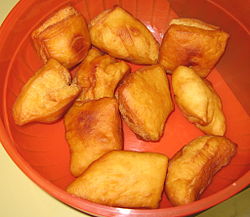Loading AI tools
Traditional fried dough of Central Asian and Middle Eastern cuisines From Wikipedia, the free encyclopedia
Boortsog[lower-alpha 1] or baursaki is a type of fried dough food found in the cuisines of Central Asia, Idel-Ural, Mongolia and the Middle East.[1] It is shaped into either triangles or sometimes spheres.[2] The dough consists of flour, yeast, milk, eggs, butter, salt, sugar, and margarine.[3] Tajik boortsog are often decorated with a criss-cross pattern by pressing the bottom of a small strainer on the dough before it is fried.
This article needs additional citations for verification. (February 2011) |
 Homemade boortsog | |
| Alternative names | Boorsoq, bauyrsaq, baursak |
|---|---|
| Type | Fried dough |
| Course | Dessert |
| Main ingredients | Butter, salt water, milk, yeast, flour |
Boortsog is often eaten as a dessert, with syrup or jam or honey. They may be thought of as cookies or biscuits, and since they are fried, they are sometimes compared to doughnuts. Mongolians and Turkic peoples sometimes dip boortsog in tea. In Central Asia, baursaki are often eaten alongside chorba.[4]
Uštipci (Serbian Cyrillic: Уштипци, pronounced [uʃtɪpt͡sɪ]) are doughnut-like fried dough balls popular in Bosnia and Herzegovina, Croatia, North Macedonia, Serbia, especially in Vojvodina, Srem district and Slovenia where they are known as "miške".
Dough for boortsog ranges in ingredients from a simple dough, to a sweeter, crispier dough. For example, a typical Kyrgyz recipe calls for one part butter, seven parts salt water, and six parts milk, along with yeast and flour, while more complex recipes add eggs and sugar. Also the dough could be made with kaymak.
Boortsog are made by cutting the flattened dough into pieces. While not usually done in Central Asia, these pieces may be bent and knotted into various shapes before being deep fried. This is especially common among Mongolians. The dough is deep-fried golden brown. Mutton fat is traditionally used by Mongolians to give the boortsog extra flavor, but vegetable oil may be substituted.[5][6][7][8]
The biggest (179 kg) baursak was cooked April 20, 2014, in Ufa, Russia. 1,006 eggs, 25 kg of sugar, 70 kg of flour, 50 kg of Bashkir honey were used for its preparation.[9] A Guinness record was made in Almaty, September 7, 2014, during the celebration of Mother's Day, when 856 kilograms of baursaks were cooked in one place in one day. The celebration was held in the form of a culinary battle between teams of mothers-in-law and daughters-in-law. Seven teams participated in the competition.[10]
Seamless Wikipedia browsing. On steroids.
Every time you click a link to Wikipedia, Wiktionary or Wikiquote in your browser's search results, it will show the modern Wikiwand interface.
Wikiwand extension is a five stars, simple, with minimum permission required to keep your browsing private, safe and transparent.